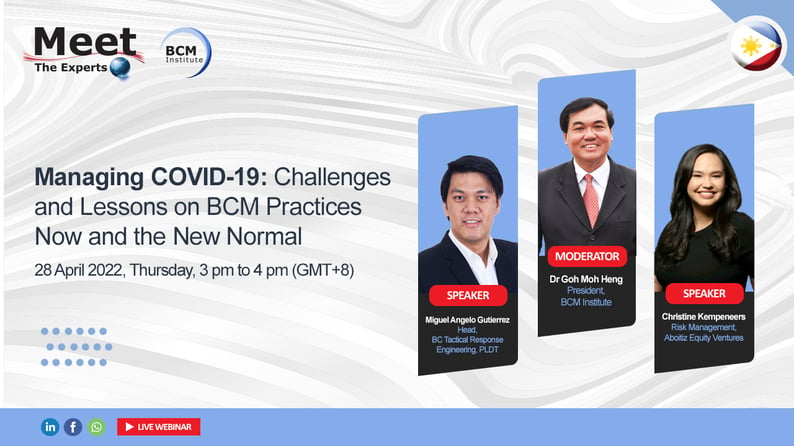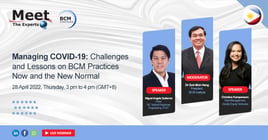
Managing Business Continuity During and Post COVID-19 for a Telecommunication Company

 Miguel E. Gutierrez, BCCE, CMCS is the Senior Manager and Head of Business Continuity, Tactical Response Engineering Division at PLDT spoke on this topic. Click the photo to find out more about Miguel.
Miguel E. Gutierrez, BCCE, CMCS is the Senior Manager and Head of Business Continuity, Tactical Response Engineering Division at PLDT spoke on this topic. Click the photo to find out more about Miguel.
Synopsis
The talk discussed how PLDT, one of the leading telecommunications companies in the Philippines, responded to the Covid 19 pandemic. The various responses and programs of the company were discussed, as well as the Business Continuity Initiatives that continued to be incorporated in the activities of the company during the pandemic. The lessons learned and best practices were also discussed during the presentation.
The timeline of how the Covid 19 pandemic started to be strongly felt in the Philippines was discussed. Along with the timeline, the company responses during this initial phase were also discussed. These actions helped the company respond fast to the pandemic.
In the heart of the company’s response is the employees. The goal was to not only protect the employees but also to strengthen the employees. These were done primarily by the three main focus – Reduce Transmission, Protect Employees, and Take Care of the Employees.
Transmission was reduced by the early decision to lockdown critical sites of the company, even before the lockdown was declared by the government. Identified critical sites were locked down and employees were asked to temporarily stay inside the building 24/7. They were provided with food, sleeping and bath requirements, and even entertainment items and activities. Other employees were also allowed to work from home. Also, a 24/7 command centre was established to support the lockdown sites as well as other employees of the company.
Employees were protected by the company by giving them more than the essentials. PPEs were given, including vitamins to help strengthen the employees. For those who were inside the offices, there were engineering controls to help reduce the transmission of the virus and protect the employees. Also, awareness materials were also continuously sent to employees to keep them updated and remind them what should be done to protect themselves and their families.
The company also helped take care of employees by the early release of the 13th-month pay, instituting Covid 19 leaves, ensuring the Covid 19 hotline was always updated, and that various support was given to employees who were affected by Covid 19, especially at the onset of the pandemic.
The years 2020 until the present were very eventful and challenging. We are still in a pandemic, but as a country, we have also been experiencing various calamities and disasters. Various strong typhoons continue to affect the country. Also, we still have volcanic eruptions. Response is made difficult because of social distancing measures and it highlights the importance of being prepared and having the ability to make alternate ways of responding to various situations.
The pandemic and the hybrid working arrangement are not excuses to stop Business Continuity initiatives. In fact, the situation we are in highlights the need for a stronger business continuity program and awareness. In the company, ISO certifications and re-certifications were continued, together with new initiatives such as virtual summits to help various groups prepare and equip themselves, as well as online and recorded trainings to help them create Business Continuity Plans.
As we continue to navigate through this pandemic, we have realized some essential lessons that helped us as a company. One is to continue to research and be open to new knowledge to keep us updated and help us be aware of new ways of improving how we do things and how we respond to this pandemic. Another one is to be agile since it is important to be fast in decision making as we incorporate new knowledge and best practices. Another is to maximize technology, to be able to improve ways of doing things and remain efficient. Teamwork is also very important as no one is a subject matter expert and we all need to work together to be able to produce the best results. Lastly, it is critical to remain compassionate to our employees and make them realize how important they are to the company so we can also continue to function well and serve the Filipino People.
2022 Confirmed MTE Live Webinars
Come Join Our Online Blended Learning Training with Certification
| Back To | ||||
|
|
Reference Guide |
 |
 |
|
| Goh, M. H. (2016). A Manager’s Guide to Implement Your Infectious Disease Business Continuity Plan, 2nd Edition. GMH Pte Ltd. | ||||







 "Managing COVID-19 in the Philippines: Challenges and Lessons on BCM Practices Now and the New Normal" presented on 28 April 2022 by
"Managing COVID-19 in the Philippines: Challenges and Lessons on BCM Practices Now and the New Normal" presented on 28 April 2022 by 


![[BL-3-Catalog] What Specialist Level Blended Learning Courses that are Available?](https://no-cache.hubspot.com/cta/default/3893111/4b22a53c-6e3e-4b9e-8c2a-888423f1d26c.png)
![[BL-5-Catalog] What Expert Level Blended Learning Courses that are Available?](https://no-cache.hubspot.com/cta/default/3893111/fe175db3-7f57-4636-bf09-e9a836aa5478.png)


